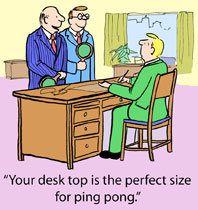“We need to…”
 Imagine the sound of a ping pong ball falling on a hard surface. It bounces, bounces, bounces some more, and faster as it bounces away, and then bounces again, and then stops until someone picks it up and either bounces it again, or puts it in play. The phrase, “We need to…” is like that. You can insert whatever ending you like. It might be, “We need to get the roof repaired.” “We need to change that policy.” “We need to ensure we mesh our cultures.” Now imagine a CEO making such a statement to the executive team. “We need to make sure that before this merger, our two companies understand each other’s culture,” for example. What happens next? Bounce, bounce, bounce.
Imagine the sound of a ping pong ball falling on a hard surface. It bounces, bounces, bounces some more, and faster as it bounces away, and then bounces again, and then stops until someone picks it up and either bounces it again, or puts it in play. The phrase, “We need to…” is like that. You can insert whatever ending you like. It might be, “We need to get the roof repaired.” “We need to change that policy.” “We need to ensure we mesh our cultures.” Now imagine a CEO making such a statement to the executive team. “We need to make sure that before this merger, our two companies understand each other’s culture,” for example. What happens next? Bounce, bounce, bounce.
Well that’s the question, isn’t it? When anyone makes such a statement what is the expectation? Is the one asking the question going to do it? Is the listener supposed to do the action? You know you’ve made such a statemen; and I’m sure you’ve heard it from someone.
OK, you’re the CEO and what you say goes. When you make the, “We need to…” statement, where does it go? Where does it bounce? Are you expecting everyone to grab the ball and do the task that is at the end of the, “We need to…statement? Are you just assuming that any executive team member within earshot will do it? Certainly, if we are in our executive team meeting, someone will hear it and get started on it right away!
Or maybe you’re the proverbial optimist and think that after the meeting one of your executive team members will bounce into your office bursting with enthusiasm and say, “OK boss, I want to do that thing at the end of the “We need to…” statement that you made in today’s executive meeting. Oh, please, please, can I please do it? I don’t have that much on my plate, it won’t be any problem to take it on. Oh, please can I?” Bounce, bounce, bounce…I don’t think that ball’s going to be put in play.
This scenario is repeated over and over in organizations. The way to keep the ball in play bounces to that old standby – communication. This falls into the say what you mean and mean what you say communication category. As a CEO, you cannot expect your executive team members to be mind readers. What do you have in mind? Do you have any ideas on how to get the action at the end of the “We need to…” statement accomplished? Better yet, have you asked for any ideas on how to get the action at least started?
The idea is to be clear. Here are some ideas on how to do that:
- We need to… Does anyone have any suggestions?
- We need to… What are our first steps?
- We need to… Where do we need to begin?
- We need to… What’s the best way to get started?
- If these do not solicit ideas right away, then try… “We need to make sure that before this merger, our two companies understand each other’s culture and I want each of you to come up with three to five ideas on how best to accomplish this at next executive meeting.”
If you are following a change model, it should then be an easy task to plug that it to your actionable steps. Part of making change work is determining who is best at what role and assigning the task providing all necessary guidelines. Prosci offers a PDF on assigning roles during change. Offering an easy model to follow is Kotter International. This model, too, stresses the importance of assigning roles. Organizations such as Performance Strategies, Inc. helps to discern who is best suited for what role and then helps ensure roles stay on track by offering coaching.
Letting ideas and communication bounce around without fulfillment is a recipe for disaster. Ensure your change initiatives stay on track by keeping your ideas in play.
Thank you for reading this blog. If you think we need to …talk about assigning roles for your change initiatives, call 404-320-7834, or email This email address is being protected from spambots. You need JavaScript enabled to view it., or visit www.performstrat.com.
Graphic Credit: BigStock.com Copyright: cartoon resource